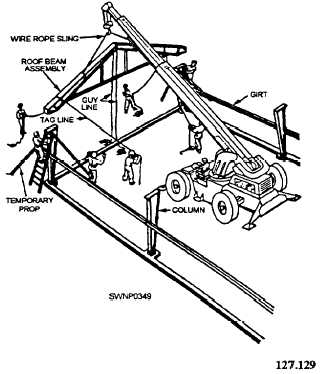of turns around, such as the bumper of a truck. Then, if the frame should go beyond the vertical, the tag person would be able to keep it from falling.
To get the frame started from the ground, it should be lifted by several people and propped up as high as practical. Bolt an cave strut to each column, as shown in figure 8-5. The cave struts allow the frame to be propped at every stage of the lifting. After the frame is in a vertical position, install guy lines and props to it so it cannot move.
Now, raise the second frame in the same way, and hold it vertically in place by installing purlins, girts, and brace rods.
A crane or other suitable type of power equipment can be used to hoist the frames into place where such equipment is available. When power equipment is used, the suggested procedure to comply with is as follows:
1. Raise the columns and bolt them to the base shoes and then brace them in plain.

Figure 8-6. - Using power equipment.
2. Install all sidewall girts to keep the columns as rigid as possible.
3. Bolt the roof beams together and install the the gable posts and end-wall header.
4. Secure the guy lines, and tag lines to the roof beams, as shown in-figure 8-6. Attach a wire rope sling at approximately the center of each roof beam.
5. Hoist the roof beams into position on top of the columns and bolt them in place.
6. When the second rigid-frame section is secured in position, install all of the roof purlins, the gable angles, and the louver angles. Attach the gable clips to the purlins before raising into position.
7. Install the brace rods and align the first bay. THE FIRST BAY MUST BE ALIGNED BEFORE ERECTING ADDITIONAL BAYS.
Brace Rods
Brace rods must be installed in the first bay erected (fig. 8-7). These rods are of paramount importance.
With the rods installed, plumb each frame column with carpenter's spirit level.
Check the distance diagonally from the uppercomer of one frame to the lower comer of the adjacent frame. When this distance is the same for each rod, the columns will be plumb. After the sidewall rods are installed, install the roof rods. The length of the roof rods can be adjusted by tightening or loosening the turnbuckle. When the two diagonal measurements are the same, the end bay will be square.
After the two frames have been plumbed and braced square with the diagonal rods (and the purlins, the girts, and the eave struts have been installed), the guy lines or props can be removed and the remaining frames of the building can be erected. To raise the next frame, attach blocks to the last frame raised.
Do not omit the diagonal brace rods that are required in the last bay of the building.
Be sure and bolt the girts, the purlins, and the since the y hold the frames in an upright position. cave struts to the inside holes of the end frames. THEY SHOULD NEVER BE OMITTED.
Install the cave struts, the girts, and the purlins The diagonal brace rods are attached to the frames in each bay as soon as a frame is erected. in the roof and sidewall through the slotted holes
Exercise care to see that the diagonal brace rods provided. Use a half-round brace rod washer and a flat are taut and do not project beyond the flanges of the end steel washer under the nuts at each end of the rods. frame to interfere with end-wall sheeting.Continue Reading
